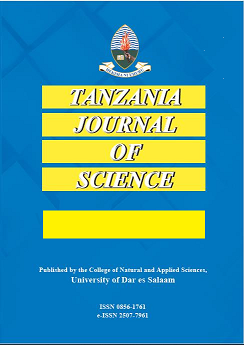Constraining the Origin and Age of the Thermal and Cold Water in the Lake Natron Basin, Northern Tanzania
DOI:
https://doi.org/10.4314/tjs.v48i4.8Keywords:
thermal water, Lake Natron Basin, stable isotopes, springsAbstract
Springs on the eastern and western shores of Lake Natron Basin (LNB), located within the eastern branch of the East Africa Rift System (EARS) in Northern Tanzania had a discharge temperature that ranged between 34.0 °C and 51.2 °C, while the pH varied from 8.0 to 10.7. The electrical conductivity (EC) ranged between 5,007 µS/cm and 49,200 µS/cm. Cold waters had a temperature of 31.9 °C to 32.5 °C, while the pH ranged between 8.0 and 8.3, and the EC ranged between 1,401 µS/cm and 3,806 µS/cm. The stable isotope composition varied between -2.4 ‰ and -5.3 ‰ for δ18O, and -15.5 ‰ to -29.3 ‰ for δ2H. The isotopic composition of thermal and cold water of LNB indicates a significant contribution of meteoric water in the recharge of the hydrothermal system. However, thermal water is affected by evaporation, water-rock interaction, carbon dioxide (CO2) exchange and condensation processes. Tritium analysis indicated that the spring water in the LNB hydrothermal system has a residence time of more than 50 years.


